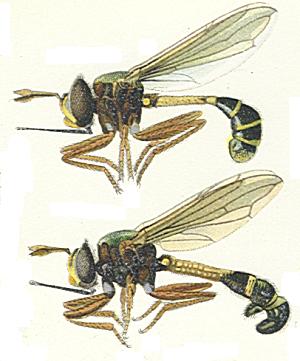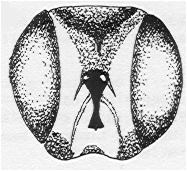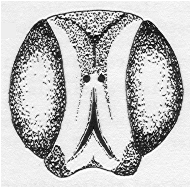
1.a. Sides of thorax without silverish stripe -> 2
1.b. Side of thorax with silverish stripe, from the implant of the wing to the base of leg 2 -> 4
2.a. Face below antennal implant with a black stripe, above the antennal implant partly blackish -> 3
2.b. Face yellow, without black stripe below and blackish parts above antennal implant 9-16 mm. NL, B, D, southern Europe. -> Physocephala vittata Fabricius (= P. curticornis)
3.a. Face: black stripe below antennal implant rounded at its lower end; antennae blackish; hind edges of tergites 3-5 with wide, vaguely delimited dust bands which are clearly broader in the middle -> Physocephala rufipes (Fabricius) (=P.laticincta)
3.b. Face: black stripe below antennal implant deeply
forked into two arms; antennae red; femur uniformly reddish; hind edges
of tergites 3-5 with narrow, clearly delimited dust bands of even width.
15-20 mm. NL, B, D. -> Physocephala nigra DeGeer


Head of P. rufipes, with black stripe rounded below and P.
nigra, with black stripe forked below.
4.a. Silverish stripe on sides of thorax equally wide from upper to lower part. Female: theca not elongated -> 5
4.b. Silverish stripe on sides of thorax broadening from upper to lower part. Female: theca elongated. Southern Europe -> Physocephala vaginalis (Rondani)
5.a. Wing: basal radial cell br completely of mainly without microtrichia -> 6
5.b. Wing: all cells completely covered with microtrichia, including basal radial cell br -> 7
6.a. Head: parafacia completely silver-white dusted; arista 3 segmented; wing: dark stripe almost lacking and not well marked, no dark spot in wing tip; antennae red to red-brown; abdomen: in females largely redbrown, in males largely blackish, with yellowish dust bands at the hind margins of all tergites; legs yellow-red. 11-16 mm. -> Physocephala variegata Meigen
6.b. Head: parafacia at most narrowly dusted at eye margin; arista 2 segmented; wing: dark stripe variable, almost lacking to clearly developed. Italy, Greece, near east. -> Physocephala antiqua (Wiedemann)
7.a. Wing: dark stripe does not directly border the front margin of the wing over its full length, the first wing cell whitish, hyaline or only weakly coloured; legs red, orange or yellow-red, base of tibia turning whitish -> 8
7.b. Wing: dark stripe borders the front margin of the wing over its full length; face yellow, below antennal implant often with dark patches; antennae dark brown; legs red-brown to blackish. 5-12 mm. -> Physocephala pusilla Meigen (= P. lacera)
8.b. Hind coxa: dusting variable, but less densily than the dusting of the front and middle coxae, dusting may lack completely; face usually with two narrow black stripes along the facial keel; arista 3-segmented, first aristal segment small; the dark wing band does not reach up to the end of cell R2. 9.5-16 mm. Central and Southern Europe -> Physocephala vittata colour morph truncata
Stuke J.-H. 2005. Bestimmung und Taxonomie der palaarktischen Conopiden (Diptera) 1. Teil: Die Physocephala rufipes-Artengruppe. Studia dipterologica 12: 369-384.
StukeJ.-H.2016.Taxonomic notes on Western Palaearctic Conopidae (Diptera). Zootaxa4178(4):521-534.
Van Veen M. 1984. De Blaaskopvliegen en roofvliegen van Nederland en België. Jeugdbondsuitgeverij, Utrecht.